Uploads by Alex.peterson
From CreationWiki
Jump to navigationJump to search
This special page shows all uploaded files.
| Date | Name | Thumbnail | Size | Description | Versions |
|---|---|---|---|---|---|
| 00:04, 2 June 2015 | DNA microinjection.png (file) | 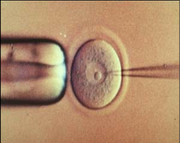 |
507 KB | The process of DNA microinjection involves directly inserting foreign DNA into a zygote of an organism. (Image by University of California Irvine) | 1 |
| 16:37, 31 May 2015 | GMO sign.jpg (file) | 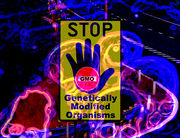 |
901 KB | Public outcry against genetically modified organisms has stunted much research into this field and has resulted in several GMO product bans. (Image by Miran Rijavec) | 1 |
| 02:48, 28 May 2015 | African cattle.jpg (file) | 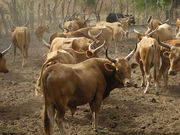 |
323 KB | Through selective breeding, cattle populations may be more tolerant of certain diseases, increasing their lifespan and productivity. (Image by Steven Walling) | 1 |
| 02:29, 28 May 2015 | Disease resistance in cattle table.png (file) | 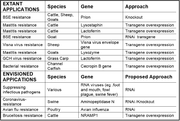 |
164 KB | Scientists take several approaches to genetically modify livestock to enhance their resistance to diseases. (Table by Bill Pohlmeier and Alison Van Eenennaam ) *Note: The use of this image was granted through direct permission from the author. | 1 |
| 21:29, 27 May 2015 | Modifiedcattle.jpg (file) |  |
395 KB | The use of antibiotics in agriculture serves to increase productivity and efficiency. (Image by Ryan Thompson) | 1 |
| 02:29, 6 May 2015 | A-tocopherol.png (file) |  |
2 KB | Alpha-tocopherol is a lipophilic antioxidant that is commonly known as Vitamin E. | 1 |
| 05:44, 4 May 2015 | Antioxidant pathway.png (file) | 78 KB | Enzymatic antioxidants neutralize harmful free radicals in the body. (Image by Tim Vickers) | 1 | |
| 05:32, 4 May 2015 | Antioxidant pathway.svg (file) | 17 KB | Enzymatic antioxidants in the body neutralize harmful free radicals. | 1 | |
| 22:15, 26 April 2015 | Protein electrophoresis.png (file) | 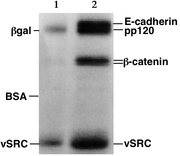 |
64 KB | Proteins, often treated with a detergent such as sodium dodecyl sulfate (SDS), can be separated by gel electrophoresis to identify them. (Image by John Schmidt) | 1 |
| 20:18, 22 April 2015 | Free radical.jpg (file) | 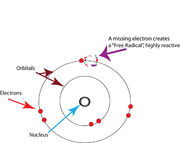 |
27 KB | Free radicals attempt to fulfill their valence electron balance by taking the electrons of nearby chemicals, creating additional free radicals. (Image by Healthvalue) | 1 |
| 06:09, 20 April 2015 | Antioxidant multivitamin.jpg (file) |  |
525 KB | Multivitamins may contain antioxidants, essential minerals, and nutrients to supplement one's diet. (Photo by Ragesoss) | 1 |
| 05:00, 20 April 2015 | Antioxidant fruits.gif (file) | 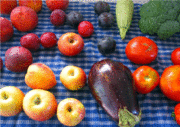 |
408 KB | Antioxidants neutralize free radicals, which react with surrounding chemicals and damage cell particles. (Image by Emerika) | 1 |
| 03:06, 20 April 2015 | Antioxidant metabolite glutathione.png (file) |  |
154 KB | Antioxidants, such as metabolite glutathione, rid the body of harmful free radicals. (Image by Ben Mills) | 1 |
| 02:44, 20 April 2015 | OliverSmithies.JPG (file) |  |
405 KB | Oliver Smithies first used gel electrophoresis in 1955 and was later awarded several awards for his work in biochemistry, including the American Institute of Chemistry Gold Medal (shown in picture). (Image by Douglas A. Lockard) | 1 |
| 05:20, 9 April 2015 | DNA fingerprint.jpg (file) | 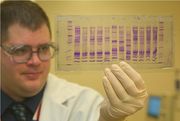 |
169 KB | By separating bands of DNA fragments by size, scientists can create a DNA profile unique to an organism. (Image by James Tourtellotte) | 1 |
| 05:03, 9 April 2015 | Gel casting tray.png (file) | 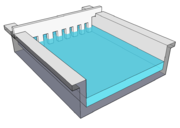 |
37 KB | When filling a gel casting tray, pour the agarose solution several millimeters up the comb teeth, ensuring that the solution does not touch the comb frame. (Image by Jacopo Werther) | 1 |
| 03:35, 9 April 2015 | Gel electrophoresis.jpg (file) | 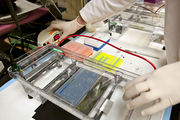 |
1.52 MB | Gel electrophoresis separates bands of dye or DNA fragments based on electrical charge and size. (Image by School of Natural Resources from Ann Arbor) | 1 |
| 00:24, 28 January 2015 | Drop of cannabis oil.jpg (file) | 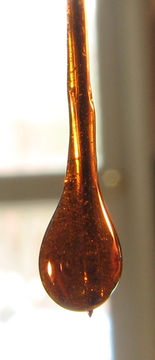 |
262 KB | This drop of cannabis "hash oil" is composed primarily of THC. (Photo by Ryan Bushby) | 1 |
| 23:52, 27 January 2015 | Oh synthetic thc.png (file) |  |
11 KB | HU-210 is a synthetic cannabinoid receptor antagonist used in drugs mimicking THC. (Photo by Cacycle) | 1 |
| 03:09, 14 January 2015 | THC!.gif (file) |  |
752 KB | This animation shows a tetrahydrocannabinol molecule. | 1 |
| 02:27, 14 January 2015 | Talpid2 chick and alligator.jpg (file) | 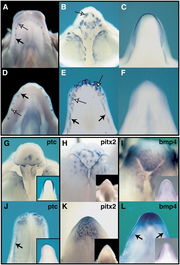 |
58 KB | These images show a side-by-side embryonic development of alligators and talpid2 chicks. Both show a similar arrangement of shh expression for apparent tooth development. (Image by Matthew P. Harris, Sean M. Hasso, Mark W.J. Ferguson, John F. Fallon) | 1 |
| 01:12, 12 January 2015 | 2DTetrahydrocannabinol.png (file) |  |
13 KB | A 2D delta9-tetrahydrocannabinol molecule model. (Model by Yikrazuul) | 1 |
| 01:07, 12 January 2015 | Tetrahydrocannabinolmolecule.png (file) | 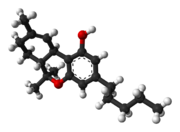 |
174 KB | A 3D delta9-tetrahydrocannabinol molecule model. (Model by Benjah-bmm27) | 1 |
| 22:02, 11 January 2015 | Chickenteethscientific.jpg (file) | 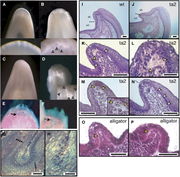 |
138 KB | These images show the small protuberances developing from the mutant talpid2 chicks' beak. | 1 |
| 16:53, 14 December 2014 | Creationist orchard.gif (file) | 5 KB | According to Creationism, each kind was created uniquely and gave rise to further speciation within its orginal kind. | 1 | |
| 16:40, 14 December 2014 | Mutant chicken beak.jpg (file) |  |
17 KB | The beak of a mutant chicken with the talpid2 gene, bearing tiny teeth along its jaw. (Photo by Matthew Harris and John Fallon.) | 1 |
| 16:35, 14 December 2014 | Beak comparison.jpg (file) |  |
54 KB | On the left is a healthy chicken's beak. On the right is a chicken with the recessive talpid2 gene, showing tiny tooth buds. (Photo by Matthew Harris and John Fallon) | 1 |
| 01:18, 19 November 2014 | Splashtin.jpg (file) | 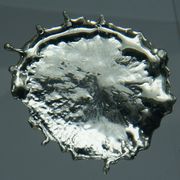 |
422 KB | Tin is a poor metal with many unique characteristics. | 1 |
| 05:00, 25 October 2014 | Dinosaurstones.png (file) |  |
724 KB | Ancient depictions of large reptilian creatures indicates that humans and dinosaurs lived simultaneously. | 1 |
| 04:16, 25 October 2014 | Project creation logo.png (file) | 25 KB | Project Creation serves to educate Christians and empower them to defend their faith. | 1 | |
| 03:00, 16 October 2014 | MeekPresentation.jpg (file) | 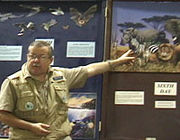 |
11 KB | Sean Meek, director of Project Creation, presents a seminar on animals. | 1 |
| 02:38, 16 October 2014 | Sean project creation.jpg (file) |  |
11 KB | Sean Meek, executive director of Project Creation, speaks nationally on subjects of biblical controversy. | 1 |
| 16:06, 12 October 2014 | Sn-Alpha-Beta.jpg (file) | 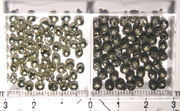 |
495 KB | Tin transitions into a non-usable grey tin if left under 13.2 degrees Celcius. (Image by Alchemist-hp) | 1 |
| 15:55, 12 October 2014 | Tin ceiling.jpg (file) | 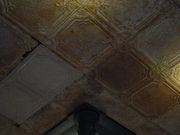 |
287 KB | Ceilings made of pressed tin were very popular during the Victorian era. (Image by Joe Mabel) | 1 |
| 01:25, 12 October 2014 | Casserite.jpg (file) | 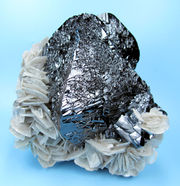 |
258 KB | Casserite (SnO2) is a common compound of tin found in nature. | 1 |
| 01:40, 27 May 2014 | Many trumpet pitchers.jpg (file) | 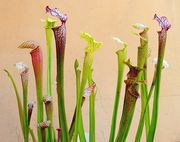 |
427 KB | These trumpet pitcher plants use long pitchers to catch insects. (Photo by Noah Elhardt) | 1 |
| 00:16, 27 May 2014 | Pitcher plant garden.jpg (file) | 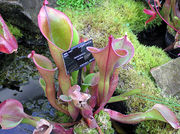 |
1.94 MB | Pitcher plants often have several pitchers, in case one is damaged or becomes aged. (Photo by Adrian Pingstone) | 1 |
| 05:08, 13 May 2014 | Pitcherfullplant.jpg (file) |  |
157 KB | Pitcher plants may possess several ground-based pitchers with a single flower growing from a long stem. (Photo by "Science and Plants for Schools") | 1 |
| 04:27, 13 May 2014 | Pitcher plant flower.jpg (file) | 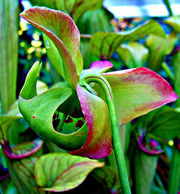 |
212 KB | The flowers of pitcher plants are hung upside down to catch pollen like a pitcher. (Photo by CameliaTWU) | 1 |
| 00:23, 13 May 2014 | Nepenthes gracilis with ant.png (file) | 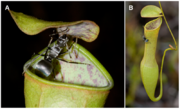 |
557 KB | This pitcher plant lures a large ant, which will likely become its next meal. (Photo by Bauer) | 1 |
| 00:08, 13 May 2014 | NepenthesBurkei pitcher plant.jpg (file) | 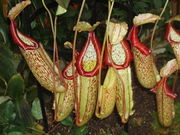 |
102 KB | Pitcher plants hang from tendrils and lure insects into their wide cauldrons, which contains digestive juices inside. (Photo by David Hawgood) | 1 |
| 03:21, 12 May 2014 | PitcherplantSarraceniaoreophila.jpg (file) | 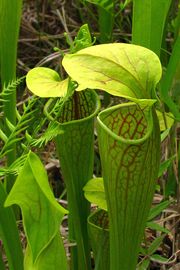 |
234 KB | This pitcher plant of the genus Sarracenia is one of the many North American pitcher plants, also known as trumpet pitchers. | 1 |
| 00:46, 7 April 2014 | Red-spotted garter.jpg (file) | 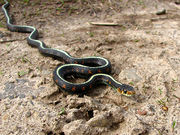 |
183 KB | This red-spotted garter snake slithers in search of food. (Picture by Ben Amstutz -- Image has not been modified) | 1 |
| 00:39, 7 April 2014 | California red-sided garter snake.jpg (file) |  |
515 KB | This California Red-sided garter snake is characterized by red and blue stripes along its body. | 1 |
| 21:49, 6 April 2014 | Snake eating frog.jpg (file) | 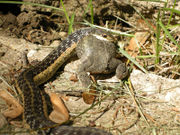 |
1.22 MB | This garter snake catches a large toad in its elastic jaws. (Photo by Caleb Putnam -- image has not been modified) | 1 |
| 04:20, 24 March 2014 | Thamnophis cyrtopsis ocellatus.jpg (file) | 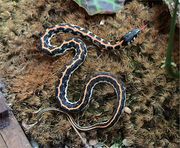 |
124 KB | This Blackneck Garter Snake, Thamnophis cyrtopsis ocellatus, is unique for its complex color pattern stretching along its length. (Photo by Dawson) | 1 |
| 04:14, 24 March 2014 | California garter snake.jpg (file) | 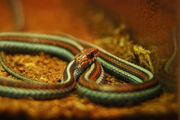 |
315 KB | This garter snake, Thamnophis sirtalis tetrataenia, is a colorful variety of the common garter snake, which can be used as a pet. (Photo by Nicole Corpuz) | 1 |
| 00:28, 24 March 2014 | Coast Garter Snake.jpg (file) | 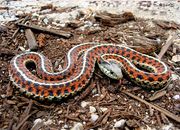 |
393 KB | Thamnophis elegans terrestris is a colorful garter snake that lives in northern and central California. | 1 |
| 00:08, 24 March 2014 | Breeding garter snakes.jpg (file) | 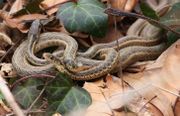 |
62 KB | During early spring, male garter snakes will frenetically attempt to mate with a female, who attracts many males with pheremones. | 1 |
| 23:24, 23 March 2014 | Thamnophis range.png (file) |  |
13 KB | Thamnophis is the most widely distributed genus of snakes in North America. (Map created by Craig Pemberton -- image has not been modified) | 1 |